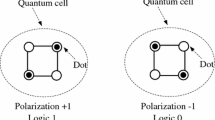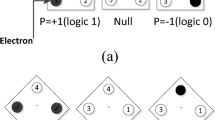Abstract
Quantum-dot cellular automata (QCA) is the appearance of new technology and can be a suitable alternative to semiconductor transistor technology. In this paper, the new structure of the two-input XOR gate is presented, which is the modified version of the three-input XOR gate. This structure can be used to design various useful QCA circuits. By utilizing this gate, we design and implement a new full adder structure with 90-degree cells. This structure is designed in a single layer without cross-wiring. The operation of the proposed structure has been verified by QCADesigner version 2.0.3 and energy dissipation investigated by QCAPro tool. We also compared the effectiveness of our structure with the two previous structures.







Similar content being viewed by others
References
Heikalabad SR, Navin AH, Hosseinzadeh M (2015) Midpoint memory: a special memory structure for data-oriented models implementation. J Circuits Syst Comput 24:1550063
Yu W, Zhang B, Liu C, Zhao Y, Wu WR, Xue ZY, Chen M, Buca D, Hartmann J-M, Wang X, Zhao QT, Mantl S (2014) Impact of Si cap, strain and temperature on the hole mobility of (s)Si/sSiGe/(s)SOI quantum-well p-MOSFETs. Microelectron Eng 113:5–9. https://doi.org/10.1016/j.mee.2013.06.015
Liu M (2006) Robustness and power dissipation in quantum-dot cellular automata. Ph.D. thesis, Notre dame University, Indiana
Heikalabad SR, Navin AH, Hosseinzadeh M (2016) Content addressable memory cell in quantum-dot cellular automata. Microelectron Eng 163:140–150
Fey D (2012) Optical multiplexing techniques for photonic Clos networks in High Performance Computing Architectures. J Supercomput 62(2):620–632
Bose R, Johnson HT (2004) Coulomb interaction energy in optical and quantum computing applications of self-assembled quantum dots. Microelectron Eng 75(1):43–53. https://doi.org/10.1016/j.mee.2003.11.008
Niemier MT (2004) Designing digital systems in quantum cellular automata. M.S. thesis, Notre Dame University, Indiana
Karkaj ET, Heikalabad SR (2017) Binary to gray and gray to binary converter in quantum-dot cellular automata. Optik Int J Light Electron Opt. https://doi.org/10.1016/j.ijleo.2016.11.087
Karkaj ET, Heikalabad SR (2017) A testable parity conservative gate in quantum-dot cellular automata. Superlattices Microstruct. https://doi.org/10.1016/j.spmi.2016.08.054
Gadim MR, Navimipour NJ (2017) A new three-level fault tolerance arithmetic and logic unit based on quantum dot cellular automata. Microsyst Technol. https://doi.org/10.1007/s00542-017-3502-x
Jayashree HV (2016) Ancilla-input and garbage-output optimized design of a reversible quantum integer multiplier. J Supercomput 72(4):1477–1493
Valinataj M (2017) Novel parity-preserving reversible logic array multipliers. J Supercomput 73(11):4843–4867
Kotiyal S (2015) Reversible logic based multiplication computing unit using binary tree data structure. J Supercomput 71(7):2668–2693
Khan MHA (2017) Automatic synthesis of quaternary quantum circuits. J Supercomput 73(5):1733–1759
Len CS, Tougaw PD (1993) Lines of interaction quantum-dot cells: a binary wire. J Appl Phys 74:6227–6233
Rad SK, Heikalabad SR (2017) Reversible flip-flops in quantum-dot cellular automata. Int J Theor Phys 56(9):2990–3004. https://doi.org/10.1007/s10773-017-3575-4
Barughi YZ, Heikalabad SR (2017) A three-layer full adder/subtractor structure in quantum-dot cellular automata. Int J Theor Phys 56(9):2848–2858. https://doi.org/10.1007/s10773-017-3453-0
Lent CS, Tougaw PD, Porod W, Bernstein GH (1993) Quantum cellular automata. Nanotechnology 4(1):49–57
Lent C, Tougaw P (1997) A device architecture for computing with quantum dots. Proc IEEE 85(4):541–557
Asfestani MN, Heikalabad SR (2017) A unique structure for the multiplexer in quantum-dot cellular automata to create a revolution in design of nanostructures. Phys B Phys Condens Matter. https://doi.org/10.1016/j.physb.2017.02.028
Asfestani MN, Heikalabad SR (2017) A novel multiplexer-based structure for random access memory cell in quantum-dot cellular automata. Phys B Phys Condens Matter. https://doi.org/10.1016/j.physb.2017.06.059
Angizi S, Alkaldy E, Bagherzadeh N, Navi K (2014) Novel robust single layer wire crossing approach for exclusive or sum of products logic design with quantum-dot cellular automata. J Low Power Electron 10:259–271
Abedi D, Jaberipur G, Sangsefidi M (2015) Coplanar full adder in quantum-dot cellular automata via clock-zone based crossover. IEEE Trans Nanotechnol 14:497–504. https://doi.org/10.1109/TNANO.2015.2409117
Mohammadi M, Mohammadi M, Gorgin S (2016) An efficient design of full adder in quantum-dot cellular automata (QCA) technology. Microelectron J 50:35–43
Sasamal TN, Singh AK, Mohan A (2016) An optimal design of full adder based on 5-input majority gate in coplanar quantum-dot cellular automata. Optik Int J Light Electron Opt 127(20):8576–8591
Farazkish R, Khodaparast F (2015) Design and characterization of a new fault-tolerant full-adder for quantum-dot cellular automata. Microprocess Microsyst 39(6):426–433
Ahmad F, Bhat GM, Khademolhosseini H, Azimi S, Angizi S, Navi K (2016) Towards single layer quantum-dot cellular automata adders based on explicit interaction of cells. J Comput Sci 16:8–15
Walus K, Dysart TJ, Jullien GA, Budiman RA (2004) QCADesigner: a rapid design and simulation tool for quantum-dot cellular automata. IEEE Trans Nanotechnol 3(1):2631
Tangmettajittakul O, Thainoi S, Changmoang P, Kanjanachuchai S, Rattanathammaphan S, Panyakeow S (2010) Extended optical properties beyond band-edge of GaAs by InAs quantum dots and quantum dot molecules. Microelectron Eng 87(5–8):1304–1307. https://doi.org/10.1016/j.mee.2009.12.063
Srivastava S, Asthana A, Bhanja S, Sarkar (2011) QCAPro-an error power estimation tool for QCA circuit design. In: Proceedings of the IEEE International Symposium Circuits System, pp 2377–2380
Author information
Authors and Affiliations
Corresponding author
Rights and permissions
About this article
Cite this article
Heikalabad, S.R., Asfestani, M.N. & Hosseinzadeh, M. A full adder structure without cross-wiring in quantum-dot cellular automata with energy dissipation analysis. J Supercomput 74, 1994–2005 (2018). https://doi.org/10.1007/s11227-017-2206-4
Published:
Issue Date:
DOI: https://doi.org/10.1007/s11227-017-2206-4




